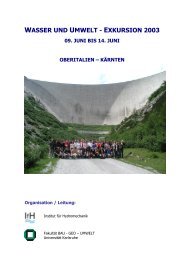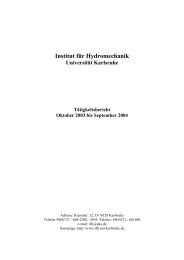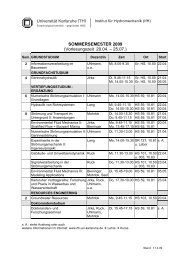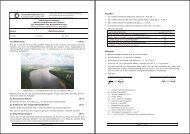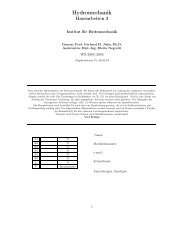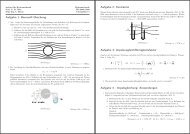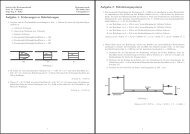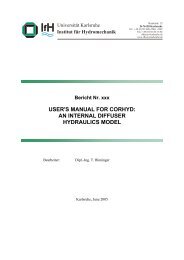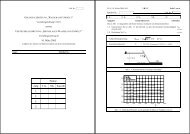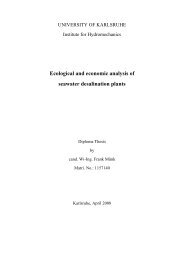Instantaneous Point-source Solution - IfH
Instantaneous Point-source Solution - IfH
Instantaneous Point-source Solution - IfH
You also want an ePaper? Increase the reach of your titles
YUMPU automatically turns print PDFs into web optimized ePapers that Google loves.
1<br />
UNIVERSITY OF KARLSRUHE<br />
Institute for Hydromechanics<br />
Directory<br />
Mixing, Transport, and Transformation<br />
Lecture 2:<br />
<strong>Instantaneous</strong> <strong>Point</strong>-<strong>source</strong> <strong>Solution</strong><br />
• Table of Contents.<br />
• Begin lecture notes.<br />
Comments and Questions: socolofsky@ifh.uka.de<br />
Last Revision Date: April 5, 2002<br />
[PgUp] [PgDn] [Back]
Table of Contents 2<br />
<strong>Instantaneous</strong> <strong>Point</strong>-<strong>source</strong> <strong>Solution</strong><br />
Table of Contents<br />
1. Review of the advective diffusion equation<br />
1.1. Fickian diffusion<br />
1.2. Advection<br />
1.3. Advective-diffusion equation<br />
2. Moving coordinate system<br />
3. Similarity solution to the one-dimensional diffusion equation<br />
3.1. Dimensional analysis<br />
3.2. Coordinate transformation<br />
3.3. <strong>Solution</strong><br />
4. Interpretation of the similarity solution<br />
5. <strong>Point</strong>-<strong>source</strong> solution with advection<br />
A. References<br />
[PgUp] [PgDn] [Back]
Section 1: Review of the advective diffusion equation 3<br />
1. Review of the advective diffusion equation<br />
Diffusion has two primary properties: it is random in nature, and<br />
transport is from high concentration to low concentration regions,<br />
with an equilibrium state of uniform concentration.<br />
1.1. Fickian diffusion<br />
A static model of one-dimensional diffusion is given in Figure 1. This<br />
model can also be viewed as an animation.<br />
This motion is described by Fick’s law, given by<br />
( ∂C<br />
⃗q = −D<br />
∂x , ∂C<br />
∂y , ∂C )<br />
∂z<br />
= −D∇C<br />
= −D ∂C .<br />
∂x i<br />
(1)<br />
Processes that obey this relationship are called Fickian diffusion processes.<br />
In water, D is of order 2·10 −9 m 2 /s (See Table 1).<br />
[PgUp] [PgDn] [Back]
Section 1: Review of the advective diffusion equation 4<br />
1.2. Advection<br />
In a current, the molecules experience two types of motion:<br />
• Due to diffusion, each molecule in time δt will move either one<br />
step to the left or one step to the right (i.e. ±δx).<br />
• Due to advection, each molecule will also move uδt in the crossflow<br />
direction.<br />
These processes are clearly additive and independent: we can use<br />
superposition.<br />
Thus, the advective-diffusive flux vector becomes<br />
⃗J = ⃗uC + ⃗q<br />
= u i C − D ∂C<br />
∂x i<br />
. (2)<br />
[PgUp] [PgDn] [Back]
Section 1: Review of the advective diffusion equation 5<br />
1.3. Advective-diffusion equation<br />
To derive the governing equation we use the control volume shown in<br />
Figure 2. From the conservation of mass, the net flux through the<br />
control volume is<br />
∂M<br />
∂t<br />
= ∑ J in − ∑ J out , (3)<br />
and for the x-direction, we have<br />
(<br />
∆J x = uC − D ∂C )∣ (<br />
∣∣∣1<br />
δyδz − uC − D ∂C )∣ ∣∣∣2<br />
δyδz. (4)<br />
∂x<br />
∂x<br />
After using Taylor-series expansion we obtain<br />
∂C<br />
∂t + ∂(u iC)<br />
∂x i<br />
the governing Advective-Diffusion (A-D) equation.<br />
= D ∂2 C<br />
∂x 2 , (5)<br />
i<br />
[PgUp] [PgDn] [Back]
Section 2: Moving coordinate system 6<br />
2. Moving coordinate system<br />
For one-dimensional diffusion in a steady flow, we can simplify (5)<br />
using a moving coordinate transformation. The new coordinates are<br />
ξ = x − (x 0 + ut) (6)<br />
τ = t, (7)<br />
The one-dimensional advective-diffusion equation with a steady current<br />
⃗u = (u, 0, 0) is<br />
∂C<br />
∂t + u∂C ∂x = D ∂2 C<br />
∂x 2 . (8)<br />
To perform the coordinate transformation, we must substitute the<br />
new coordinates into this equation. To do this we use the chain rule,<br />
giving<br />
∂C<br />
∂t<br />
∂C<br />
∂x<br />
= ∂C<br />
∂τ<br />
= ∂C<br />
∂τ<br />
∂τ<br />
∂t + ∂C ∂ξ<br />
∂ξ ∂t<br />
∂τ<br />
∂x + ∂C ∂ξ<br />
∂ξ ∂x<br />
[PgUp] [PgDn] [Back]
Section 2: Moving coordinate system 7<br />
From the definitions of the coordinate transformations we have<br />
and<br />
∂ξ<br />
∂t<br />
∂τ<br />
∂t<br />
= −u<br />
= 1<br />
∂ξ<br />
∂x = 1<br />
∂τ<br />
∂x = 0.<br />
Substituting into the governing equation (8) gives<br />
∂C ∂τ<br />
+ ∂C [<br />
∂ξ ∂C<br />
∂τ ∂t ∂ξ ∂t + u ∂ξ<br />
∂ξ ∂x + ∂C ]<br />
∂τ<br />
=<br />
∂τ ∂x<br />
( ∂ ∂ξ<br />
D<br />
∂ξ ∂x + ∂ ) (<br />
∂τ ∂C<br />
∂τ ∂x ∂ξ<br />
∂ξ<br />
∂x + ∂C<br />
∂τ<br />
)<br />
∂τ<br />
∂x<br />
(9)<br />
[PgUp] [PgDn] [Back]
Section 2: Moving coordinate system 8<br />
which reduces to<br />
∂C<br />
∂τ = D ∂2 C<br />
∂ξ 2 . (10)<br />
This is just the one-dimensional pure diffusion equation in the coordinates<br />
τ and ξ.<br />
Hence, we only need to find the point-<strong>source</strong> solution for pure<br />
diffusion.<br />
[PgUp] [PgDn] [Back]
Section 3: Similarity solution to the one-dimensional diffusion equation 9<br />
3. Similarity solution to the one-dimensional diffusion<br />
equation<br />
Consider the one-dimensional inviscid problem of a narrow, infinite<br />
pipe (radius a) as depicted in Figure 3. A mass of tracer, M, is<br />
injected uniformly across the cross-section of area A = πa 2 at the<br />
point x = 0 at time t = 0. We seek a solution for the spread of tracer<br />
in time due to pure diffusion.<br />
The governing equation is<br />
∂C<br />
∂t = D ∂2 C<br />
∂x 2 (11)<br />
which requires two boundary conditions and an initial condition:<br />
• As boundary conditions, we impose that the concentration at<br />
±∞ remain zero:<br />
C(±∞, t) = 0. (12)<br />
[PgUp] [PgDn] [Back]
Section 3: Similarity solution to the one-dimensional diffusion equation 10<br />
• The initial condition is that the dye tracer is injected instantaneously<br />
and uniformly across the cross-section over an infinitesimally<br />
small width in the x-direction:<br />
C(x, 0) = (M/A)δ(x) (13)<br />
where δ(x) is zero everywhere accept at x = 0, where it is infinite,<br />
but the integral of the delta function from −∞ to ∞ is 1.<br />
Thus, the total injected mass is given by<br />
∫<br />
M = C(x, t)dV (14)<br />
=<br />
V<br />
∫ ∞ ∫ a<br />
−∞<br />
To find the solution we use the similarity method.<br />
0<br />
(M/A)δ(x)2πrdrdx. (15)<br />
[PgUp] [PgDn] [Back]
Section 3: Similarity solution to the one-dimensional diffusion equation 11<br />
3.1. Dimensional analysis<br />
To use dimensional analysis, we must consider all the parameters that<br />
control the solution. Table 4 summarizes the dependent and independent<br />
variables for our problem. There are m = 5 parameters and<br />
n = 3 dimensions; thus, we can form two dimensionless groups:<br />
π 1 =<br />
π 2 =<br />
C<br />
M/(A √ Dt)<br />
(16)<br />
x<br />
√<br />
Dt<br />
(17)<br />
From dimensional analysis we have that π 1 = f(π 2 ), which implies<br />
for the solution of C:<br />
C =<br />
M ( ) x<br />
A √ Dt f √ (18)<br />
Dt<br />
where f is a yet-unknown function with arguement π 2 . (18) is called<br />
a similarity solution because C has the same shape in x at all times t.<br />
[PgUp] [PgDn] [Back]
Section 3: Similarity solution to the one-dimensional diffusion equation 12<br />
3.2. Coordinate transformation<br />
The similarity solution represented by (18) is really just a coordinate<br />
transformation. The new coordinate η = x/ √ Dt is called the<br />
similarity variable. For the coordinate transformation we have:<br />
Thus, we must<br />
η =<br />
1. Substitute C = M/(A √ Dt)f(x/ √ Dt).<br />
2. Substitute η = x/ √ Dt.<br />
x<br />
√<br />
Dt<br />
(19)<br />
∂η<br />
= − η (20)<br />
∂t 2t<br />
∂η<br />
∂x = 1<br />
√ . (21)<br />
Dt<br />
[PgUp] [PgDn] [Back]
Section 3: Similarity solution to the one-dimensional diffusion equation 13<br />
Using the chain rule to compute ∂C/∂t we have:<br />
∂C<br />
= ∂ [ ] M<br />
∂t ∂t A √ Dt f(η) (<br />
M<br />
=<br />
A √ − 1 ) 1<br />
Dt 2 t f(η) + M<br />
A √ Dt<br />
= − M (<br />
2At √ f + η ∂f<br />
Dt ∂η<br />
∂f ∂η<br />
∂η ∂t<br />
Using the chain rule to compute ∂ 2 C/∂x 2 we have:<br />
∂ 2 C<br />
∂x 2 = ∂ [ ( ∂ M<br />
∂x ∂x<br />
= ∂<br />
∂x<br />
=<br />
[ ∂η<br />
∂x<br />
M<br />
ADt √ Dt<br />
∂f<br />
∂η<br />
)<br />
. (22)<br />
A √ Dt f(η) )]<br />
M<br />
]<br />
A √ Dt<br />
∂ 2 f<br />
∂η 2 . (23)<br />
[PgUp] [PgDn] [Back]
Section 3: Similarity solution to the one-dimensional diffusion equation 14<br />
After substituting these two results into the diffusion equation, we<br />
obtain the ordinary differential equation in η<br />
d 2 f<br />
dη 2 + 1 (<br />
f + η df )<br />
= 0. (24)<br />
2 dη<br />
3.3. <strong>Solution</strong><br />
To solve (24) we first make use of the identity<br />
d(fη)<br />
dη<br />
= f + η df<br />
dη . (25)<br />
Substituting gives us<br />
[<br />
d df<br />
dη dη + 1 ]<br />
2 fη = 0. (26)<br />
To solve this equation requires two integrations.<br />
[PgUp] [PgDn] [Back]
Section 3: Similarity solution to the one-dimensional diffusion equation 15<br />
1. Integrating once leaves us with<br />
df<br />
dη + 1 2 fη = C 0. (27)<br />
It can be shown that choosing C 0 = 0 satisfies both boundary<br />
conditions and the initial condition (see Appendix B in the class<br />
notes).<br />
2. The second integration requires a little algebra. First, move the<br />
second term to the right-hand-side.<br />
df<br />
dη = −1 fη. (28)<br />
2<br />
Next, like terms:<br />
df<br />
f = −1 ηdη. (29)<br />
2<br />
Finally, integrate both sides:<br />
)<br />
f = C 1 exp<br />
(− η2<br />
. (30)<br />
4<br />
[PgUp] [PgDn] [Back]
Section 3: Similarity solution to the one-dimensional diffusion equation 16<br />
To find C 1 we must use the conservation of mass:<br />
∫<br />
M = C(x, t)dV<br />
=<br />
= M<br />
which gives the constraint<br />
∫ ∞<br />
−∞<br />
V<br />
∫ ∞ ∫ a<br />
−∞ 0<br />
∫ ∞<br />
−∞<br />
C(η)2πrdr √ Dtdη<br />
f(η)dη<br />
(<br />
C 1 exp − η )<br />
dη = 1. (31)<br />
4<br />
To solve this integral we need to make one more change of variables<br />
to remove the 1/4 from the exponential. Thus, we introduce ζ such<br />
that<br />
ζ 2 = 1 4 η2 (32)<br />
2dζ = dη. (33)<br />
[PgUp] [PgDn] [Back]
Section 3: Similarity solution to the one-dimensional diffusion equation 17<br />
Solving for C 1 leaves<br />
1<br />
C 1 =<br />
2 ∫ ∞<br />
−∞ exp(−ζ2 )dζ , (34)<br />
and after looking up the integral in a table, we obtain C 1 = 1/(2 √ π).<br />
Thus, f = exp(η 2 /4)/(2 √ π), and our similarity solution is<br />
( )<br />
M<br />
C(x, t) =<br />
A √ 4πDt exp − x2<br />
. (35)<br />
4Dt<br />
[PgUp] [PgDn] [Back]
Section 4: Interpretation of the similarity solution 18<br />
4. Interpretation of the similarity solution<br />
Figure 4 shows the solution (35) in non-dimensional space. The<br />
animation also plots this solution, confirming that our solution is valid<br />
for a Fickian diffusion process.<br />
Comparing (35) with the Gaussian probability distribution reveals<br />
that (35) is the normal bell-shaped curve with a standard deviation,<br />
σ, of width<br />
σ 2 = 2Dt. (36)<br />
The concept of self similarity is now also evident: the concentration<br />
profile shape is always Gaussian. By plotting in non-dimensional<br />
space, the profiles also collapse into a single profile; thus, profiles for<br />
all times t > 0 are given by the result in the figure.<br />
[PgUp] [PgDn] [Back]
Section 5: <strong>Point</strong>-<strong>source</strong> solution with advection 19<br />
5. <strong>Point</strong>-<strong>source</strong> solution with advection<br />
The final step is to substitute the coordinate transformation for the<br />
moving reference frame into the point <strong>source</strong> solution (35). In the<br />
moving coordinate system, this solution is<br />
( )<br />
M<br />
C(ξ, τ) =<br />
A √ 4πDτ exp − ξ2<br />
. (37)<br />
4Dτ<br />
Our coordinate transformation was ξ = x − (x 0 + ut) and τ = t.<br />
Substituting into (37) gives:<br />
(<br />
M<br />
C(x, t) =<br />
A √ 4πDt exp − (x − (x 0 + ut) 2 )<br />
. (38)<br />
4Dt<br />
Figure 5 shows the schematic behavior of this solution for three different<br />
times, t 1 , t 2 , and t 3 . A second animation shows this solution<br />
in action.<br />
[PgUp] [PgDn] [Back]
Figures and tables 20<br />
Figure 1: Schematic of the one-dimensional molecular (Brownian) motion<br />
of a group of molecules illustrating the Fickian diffusion model.<br />
The upper part of the figure shows the particles themselves; the lower<br />
part of the figure gives the corresponding histogram of particle location,<br />
which is analogous to concentration.<br />
(a.) Initial<br />
distribution<br />
(b.) Random<br />
motions<br />
(c.) Final<br />
distribution<br />
n<br />
n<br />
n<br />
0 x<br />
0 x<br />
0<br />
x<br />
[PgUp] [PgDn] [Back]
Figures and tables 21<br />
Table 1: Molecular diffusion coefficients for typical solutes in water<br />
at standard pressure and temperature (20 ◦ C). a<br />
Solute name Chemical symbol Diffusion coefficient b<br />
hydrogen ion H + 0.85<br />
hydroxide ion OH − 0.48<br />
oxygen O 2 0.20<br />
carbon dioxide CO 2 0.17<br />
bicarbonate HCO − 3 0.11<br />
carbonate<br />
CO 2−<br />
3 0.08<br />
methane CH 4 0.16<br />
ammonium NH + 4 0.18<br />
ammonia NH 3 0.20<br />
(10 −4 cm 2 /s)<br />
[PgUp] [PgDn] [Back]
Figures and tables 22<br />
Table 2: Molecular diffusion coefficients (continued).<br />
Solute name Chemical symbol Diffusion coefficient b<br />
nitrate NO − 3 0.17<br />
phosphoric acid H 3PO 4 0.08<br />
dihydrogen phosphate H 2PO − 4 0.08<br />
hydrogen phosphate<br />
phosphate<br />
HPO 2−<br />
4 0.07<br />
PO 3−<br />
4 0.05<br />
hydrogen sulfide H 2S 0.17<br />
hydrogen sulfide ion HS − 0.16<br />
sulfate<br />
SO 2−<br />
4 0.10<br />
silica H 4SiO 4 0.10<br />
(10 −4 cm 2 /s)<br />
[PgUp] [PgDn] [Back]
Figures and tables 23<br />
Table 3: Molecular diffusion coefficients (continued).<br />
Solute name Chemical symbol Diffusion coefficient b<br />
calcium ion Ca 2+ 0.07<br />
magnesium ion Mg 2+ 0.06<br />
iron ion Fe 2+ 0.06<br />
manganese ion Mn 2+ 0.06<br />
a Taken from diffusion coefficients web page<br />
b for water at 20 ◦ C with salinity of 0.5 ppt.<br />
c for water at 10 ◦ C with salinity of 0.5 ppt.<br />
(10 −4 cm 2 /s)<br />
[PgUp] [PgDn] [Back]
Figures and tables 24<br />
Figure 2: Schematic of a control volume with crossflow.<br />
z<br />
J x,in<br />
δz<br />
J x,out<br />
x<br />
u<br />
-y<br />
δx<br />
δy<br />
[PgUp] [PgDn] [Back]
Figures and tables 25<br />
Figure 3: Definitions sketch for one-dimensional pure diffusion in an<br />
infinite pipe.<br />
-x x<br />
A<br />
M<br />
[PgUp] [PgDn] [Back]
Figures and tables 26<br />
Table 4: Dimensional variables for one-dimensional pipe diffusion.<br />
Variable<br />
Dimensions<br />
dependent variable C M/L 3<br />
independent variables M/A M/L 2<br />
D L 2 /T<br />
x<br />
L<br />
t<br />
T<br />
[PgUp] [PgDn] [Back]
Figures and tables 27<br />
Figure 4: Self-similarity solution for one-dimensional diffusion of an<br />
instantaneous point <strong>source</strong> in an infinite domain.<br />
1<br />
<strong>Point</strong> <strong>source</strong> solution<br />
C A (4πD t) 1/2 / M<br />
0.8<br />
0.6<br />
0.4<br />
0.2<br />
0<br />
−4 −2 0 2 4<br />
η = x / (4Dt) 1/2<br />
[PgUp] [PgDn] [Back]
Figures and tables 28<br />
Figure 5: Schematic solution of the advective-diffusion equation in<br />
one dimension. The dotted line plots the maximum concentration as<br />
the cloud moves downstream.<br />
1.5<br />
<strong>Solution</strong> of the advective−diffusion equation<br />
C max<br />
Concentration<br />
1<br />
0.5<br />
t 1<br />
t 2 t3<br />
0<br />
0 1 2 3 4 5 6 7 8 9 10<br />
Position<br />
[PgUp] [PgDn] [Back]
References<br />
Fischer, H. B., List, E. G., Koh, R. C. Y., Imberger, J. & Brooks,<br />
N. H. (1979), Mixing in Inland and Coastal Waters, Academic<br />
Press, New York, NY.



